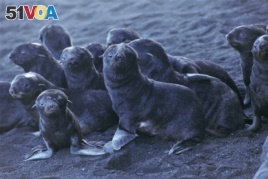15 October, 2019
For 30 years, Alaska's northern fur seal population has not increased. But the ocean mammals are appearing in growing numbers in one unlikely place -- a small island that forms the tip of an active undersea volcano.
Bogoslof Island is distant and unpopulated. It sits in the eastern Bering Sea. Openings on the ground there release mud, steam and sulfurous gases. But northern fur seals find the island to be a good place for giving birth and raising their young.
Tom Gelatt leads a group at the United States' National Oceanic and Atmospheric Administration, or NOAA. His group studies northern fur seals. Gelatt calls the population growth on Bogoslof "extraordinary."
Most of the world's 1.1 million northern fur seals live in the eastern Bering Sea area. The animals live in the ocean from November to June and return to land in summer, when they breed and nurse pups.

This August 2019 photo released by the National Oceanic and Atmospheric Administration Fisheries (NOAA) shows northern fur seal pups standing on a beach on Bogoslof Island, Alaska. (Maggie Mooney-Seus/NOAA Fisheries via AP)
But it is unclear to scientists why the seals have chosen to live on an active volcanic island instead of other unpopulated islands in the area. "The surface is covered with these big...blocks, some as big as 10 meters in length, that were exploded out of the vent," said Chris Waythomas. He is a U.S. Geological Survey research scientist at the Alaska Volcano Observatory.
About 635,000 northern fur seals live in the eastern Bering Sea area.They were first seen on Bogoslof in 1980. NOAA researchers have since carried out periodic studies of the population. In 2015, scientists estimated there were about 28,000 pups on the island.
On Bogoslof, the seals hang out on the island's rocky beaches. But they are never far away from signs of volcanic activity. The center of the island supports a field of fumaroles -- openings through which hot gases come out. Some make extremely loud noises. Mud bursts out from them and shoots several meters into the air, Waythomas said.
Northern fur seals get their name from their extremely thick fur; they have about 60,000 hairs per square centimeter. When Russian Emperor Alexander II needed money and decided to sell Alaska to the United States in 1867, fur was one of the future state's known valuables.
Between 1950 and 1988, the northern fur seal population dropped from 2.1 million to 1.1 million. Scientists do not know why they have not made a comeback.
"That's the million-dollar question," Gelatt said.
Volcanic activity on Bogoslof has remained mostly stable. But Gelatt's crew chose not to camp there during their week-long visit in August. They feared an explosion could shoot up huge rocks. Instead, they made day trips from a secured boat.
The crew counted the number of seals and examined whether images taken from above by an unpiloted aircraft could be used in future counts.
Gelatt said, "Barring other future catastrophic eruptions...there is plenty of room for a lot more seals on Bogoslof."
I'm Ashley Thompson.
The Associated Press reported this story. Ashley Thompson adapted it for VOA Learning English. Hai Do was the editor.
_________________________________________________________________
Words in This Story
pup - n. one of the young of various animals other than dogs
vent - n. an opening through which air, steam, smoke, liquid, etc., can go into or out of a room, machine, or container
stable - adj. a good state or condition that is not easily changed or likely to change
beach - n. an area covered with sand or small rocks that is next to an ocean or lake
catastrophic - adj. involving or creating sudden damage or danger
eruption - n. a sudden explosion that sends out rocks, ash, lava, etc...